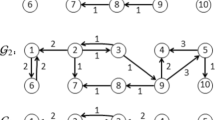Abstract
The concept of feedback-anticipative control as the extension of classical Wiener paradigm is considered in the context of multi agent systems. The behavior of complex real world agents is based on the consideration of feedback information as well as on the anticipation. A linear model of the agents with a nonlinear interaction rule is proposed as the mean for the methodological conception. The results of the developed system display a periodic response. An analytical determination of periodicity conditions for individual agents was performed by the application of z-transform. Proof of system stability for the case of two interacting agents has been provided. The hyperincursivity paradigm is presented as an interesting methodological platform for further investigation of multi agent systems.
Preview
Unable to display preview. Download preview PDF.
Similar content being viewed by others
References
Dubois, D., Resconi, G.: Hyperincursivity: a new mathematical theory. Presses Universitaires de Liège, Liège (1992)
Sycara, K.P.: Multiagent systems. AI Magazine 19(2), 79–92 (1998)
Wiener, N.: Cybernetics or Control and Communication in the Animal and the Machine. Wiley, New York (1948)
Simon, H.: Models of Man: Social and Rational – Mathematical Essays on Rational Human Behavior in a Social Setting. Wiley, New York (1957)
Dubois, D.M.: Orbital stability and chaos with incursive algorithms for the nonlinear pendulum. International Journal of Computing Anticipatory Systems 14, 3–18 (2004)
Rosenblum, M., Pikovsky, A.: Synchronization: from pendulum clocks to chaotic lasers and chemical oscillators. Contemporary Physics 44(5), 401–416 (2003)
Puu, T., Sushko, I.: A business cycle model with cubic nonlinearity. Chaos, Solitons and Fractals 19(3), 597–612 (2004)
Agarwal, R.P., et al.: Discrete Oscillation Theory. Hindawi Publishing Corp., New York (2005)
Sonis, M.: Critical bifurcation surfaces of 3d discrete dynamics. Discrete Dynamics in Nature and Society 4(4), 333–343 (1999)
Sonis, M.: Linear bifurcation analysis with application to relative socio–spatial dynamics. Discrete Dynamics in Nature and Society 1(1), 45–56 (1996)
Strogatz, S.: Nonlinear dynamics and chaos: with applications to physics, biology, chemistry and engineering. Addison-Wesley, Reading (1994)
Hogg, T., Huberman, B.A.: Controlling chaos in distributed systems. IEEE Transactions on Systems Man and Cybernetics 21(6), 1325–1332 (1991)
Kociuba, G., Heckenberg, N.R., White, A.G.: Transforming chaos to periodic oscillations. Physical Review E 64(5), 056220–1–056220–8 (2001)
Matsumoto, A.: Ergodic cobweb chaos. Discrete Dynamics in Nature and Society 1(2), 135–146 (1997)
Luenberger, D.G.: Introduction to Dynamics Systems: Theory, Models and Applications. John & Wiley Sons, Hoboken (1979)
Kreyszig, E.: Advanced Engineering Mathematics. John Wiley & Sons, Hoboken (1993)
Kljajić, M.: Contribution to the meaning and understanding of anticipatory systems. In: Dubois, D.M. (ed.) Computing anticipatory systems, pp. 400–411. American Institute of Physics (2001)
Škraba, A., et al.: Periodic cycles in discrete cobweb model. WSEAS Transactions on Mathematics 3(4), 196–203 (2005)
Škraba, A., et al.: Anticipative cobweb oscillatory agents and determination of stability regions by lyapunov exponents. WSEAS Transactions on Mathematics 12(5), 1282–1289 (2006)
Pažek, K., et al.: Ein Simulationsmodell für Investitionsanalyse der Nahrungsmittelverarbeitung auf ökologischen Betrieben in Slowenien. Bodenkultur 56(2), 121–131 (2005)
Author information
Authors and Affiliations
Editor information
Rights and permissions
Copyright information
© 2007 Springer Berlin Heidelberg
About this paper
Cite this paper
Škraba, A., Kljajić, M., Kofjač, D., Rodič, B., Bren, M. (2007). Anticipative Agent Based System Synchronization Example. In: Abramowicz, W. (eds) Business Information Systems. BIS 2007. Lecture Notes in Computer Science, vol 4439. Springer, Berlin, Heidelberg. https://doi.org/10.1007/978-3-540-72035-5_39
Download citation
DOI: https://doi.org/10.1007/978-3-540-72035-5_39
Publisher Name: Springer, Berlin, Heidelberg
Print ISBN: 978-3-540-72034-8
Online ISBN: 978-3-540-72035-5
eBook Packages: Computer ScienceComputer Science (R0)




